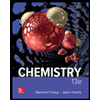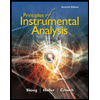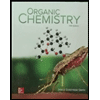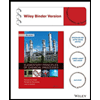
Chemistry
10th Edition
ISBN: 9781305957404
Author: Steven S. Zumdahl, Susan A. Zumdahl, Donald J. DeCoste
Publisher: Cengage Learning
expand_more
expand_more
format_list_bulleted
Question
5.
Balance the following equation:
The combustion of Butane Gas:
C4H10 + O2 ---------> CO2 + H2O (water)
answers are listed in order - 1st coefficient, 2nd coeficient, etc. and so on.
Group of answer choices
a) 1,2,2,5
b) 2,6,4,5
c) 2,13,8,10
d) 1,6,4,5
Expert Solution
This question has been solved!
Explore an expertly crafted, step-by-step solution for a thorough understanding of key concepts.
This is a popular solution
Trending nowThis is a popular solution!
Step by stepSolved in 2 steps

Knowledge Booster
Learn more about
Need a deep-dive on the concept behind this application? Look no further. Learn more about this topic, chemistry and related others by exploring similar questions and additional content below.Similar questions
- Please dont provide hand written solution.arrow_forwardBalance this equation: _UO2(s) + _ HF(£) → _ UF4(s) +_ H20(E) -> Though you would not normally do so, enter the coefficient of "1" if needed.arrow_forwardO Mail O School Loop IT Help Synergy! O SFUSD_bookmarks G Image result for car. YouTube Question 4 of 40 Balance the following chemical equation (if necessary): NasPO:(aq) + NiCl2(aq) → Nis(PO4)2(s) + NaCI(aq) 04-03-0²-|D- 03 4+ 2+ 4 8 0. O O60, Os O, Do 1 (s) (1) (g) (aq) Nis(PO:)2 NaCI NiCl Reset •x H:O Delete 91 7. 3. 2.arrow_forward
- Which set of conditions will be required for this conversion? ? A H2, Lindlar's catalyst C 2eqNa, NH3(iq) E NANH2, NH3 B H2, Pd DH", H2O F another set of conditions B Earrow_forwardcou 151 7/səzzınt es/202515/take Question 4 3 pts Predict the products and balance the equation: No Spacing between coefficients and elements/compounds. Place a "1" where assumed. Na + Br2---> Question 5 1 pts What type of reaction is this equation? KCIO3---> KCI + 02 Synthesis O Decomposition Single Replacementarrow_forwardAmmonia (NH3) is naturally produced through the decomposition of organic material as wellas being high in wastewater discharged to natural waters. In the environment it is oxidizedto form nitrite (NO2-), and nitrite is then oxidized to form nitrate (NO3-) in a process callednitrification. The balanced equations are given below:2NH3 + 3O2 → 2NO2- + 2H+ + 2H202NO2- + O2 → 2NO3-a) Assuming complete oxidation, what is the theoretical oxygen demand to convert100mg/L of ammonia to nitrate (i.e., how much oxygen is necessary)? Report youranswer as mg/L of O2.Answer: 376 mg/L O2b) This conversion process makes water more acidic. With reference to the equations forpH, explain why this occursarrow_forward
- 01 04 in the balanced equation for the complete combustion of heptane, the coefficient for carbon dioxide is: Cu + O = CO + HO Warrow_forward1. Chlorine has two isotopes, 35Cl and 37Cl. Which isotope has a higher natural abundance? Show your calculations. U 2. Extraction of aluminum from Bauxite ore starts with the following reaction: a Al₂O3 + b NaOH → c NaAlO₂ + d H₂O (a) Balance the equation, i.e., specify the values of a. b. c, and d. (b) Assuming a theoretical reaction yield, at what mass will Al₂O3 no longer be a limiting reagent in a process that also uses 40 ko of sodium hydroxide?arrow_forwardity College-CHM 101 (Section 90) - Spring20 - MARX > Activities and Due Dates > Ch 7 HW O Assignment Score: O Resources Ly Give Up? 50.1% O Hint Check Answer < Question 16 of 28 The combustion of ethane (C,H.) produces carbon dioxide and steam. 2 C,H,(s) +70,(g) → 4 CO,(g) + 6 H, O(g) How many moles of CO, are produced when 5.05 mol of ethane is burned in an excess of oxygen? moles of CO,: mol terms of use contactus help about us carecrs privacy policy MacBook Aarrow_forward
arrow_back_ios
arrow_forward_ios
Recommended textbooks for you
 ChemistryChemistryISBN:9781305957404Author:Steven S. Zumdahl, Susan A. Zumdahl, Donald J. DeCostePublisher:Cengage Learning
ChemistryChemistryISBN:9781305957404Author:Steven S. Zumdahl, Susan A. Zumdahl, Donald J. DeCostePublisher:Cengage Learning ChemistryChemistryISBN:9781259911156Author:Raymond Chang Dr., Jason Overby ProfessorPublisher:McGraw-Hill Education
ChemistryChemistryISBN:9781259911156Author:Raymond Chang Dr., Jason Overby ProfessorPublisher:McGraw-Hill Education Principles of Instrumental AnalysisChemistryISBN:9781305577213Author:Douglas A. Skoog, F. James Holler, Stanley R. CrouchPublisher:Cengage Learning
Principles of Instrumental AnalysisChemistryISBN:9781305577213Author:Douglas A. Skoog, F. James Holler, Stanley R. CrouchPublisher:Cengage Learning Organic ChemistryChemistryISBN:9780078021558Author:Janice Gorzynski Smith Dr.Publisher:McGraw-Hill Education
Organic ChemistryChemistryISBN:9780078021558Author:Janice Gorzynski Smith Dr.Publisher:McGraw-Hill Education Chemistry: Principles and ReactionsChemistryISBN:9781305079373Author:William L. Masterton, Cecile N. HurleyPublisher:Cengage Learning
Chemistry: Principles and ReactionsChemistryISBN:9781305079373Author:William L. Masterton, Cecile N. HurleyPublisher:Cengage Learning Elementary Principles of Chemical Processes, Bind...ChemistryISBN:9781118431221Author:Richard M. Felder, Ronald W. Rousseau, Lisa G. BullardPublisher:WILEY
Elementary Principles of Chemical Processes, Bind...ChemistryISBN:9781118431221Author:Richard M. Felder, Ronald W. Rousseau, Lisa G. BullardPublisher:WILEY

Chemistry
Chemistry
ISBN:9781305957404
Author:Steven S. Zumdahl, Susan A. Zumdahl, Donald J. DeCoste
Publisher:Cengage Learning

Chemistry
Chemistry
ISBN:9781259911156
Author:Raymond Chang Dr., Jason Overby Professor
Publisher:McGraw-Hill Education

Principles of Instrumental Analysis
Chemistry
ISBN:9781305577213
Author:Douglas A. Skoog, F. James Holler, Stanley R. Crouch
Publisher:Cengage Learning

Organic Chemistry
Chemistry
ISBN:9780078021558
Author:Janice Gorzynski Smith Dr.
Publisher:McGraw-Hill Education

Chemistry: Principles and Reactions
Chemistry
ISBN:9781305079373
Author:William L. Masterton, Cecile N. Hurley
Publisher:Cengage Learning

Elementary Principles of Chemical Processes, Bind...
Chemistry
ISBN:9781118431221
Author:Richard M. Felder, Ronald W. Rousseau, Lisa G. Bullard
Publisher:WILEY